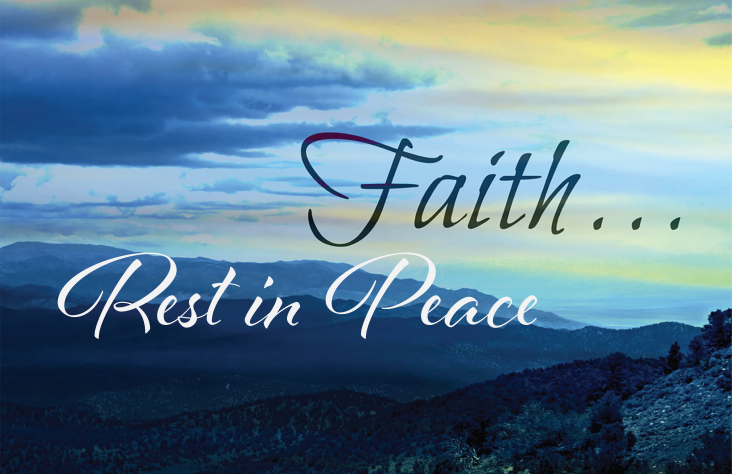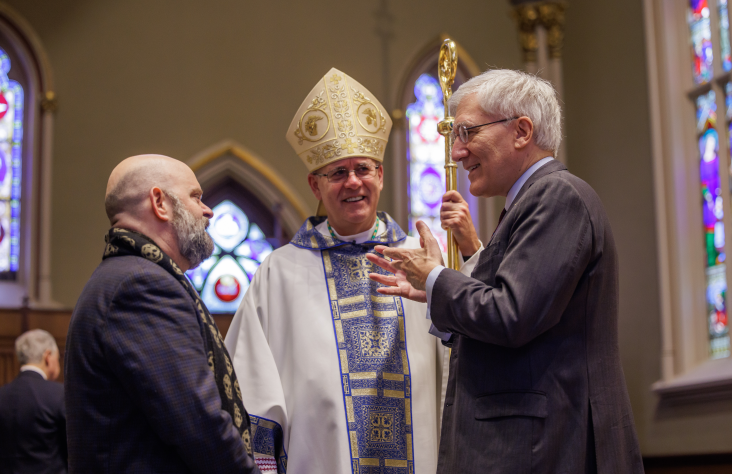October 26, 2011 // Local
Honoring the dead awakens new trends
By Kay Cozad
HUNTINGTON — Honoring the dead in the current fast-paced American culture is a far cry from what once was an enduring community affair, says Michael McElhaney, funeral director of McElhaney-Hart Funeral Home in Huntington. McElhaney says he has seen “great changes” in the two decades he has served in the funeral business.
“It used to be the whole community was behind the funeral. They used to close stores down for the funerals. Depending on who it was they’d shut the whole town down,” recalls McElhaney.
Historically, the funeral wake, also currently referred to as the showing, viewing, visitation or calling hours, consisted of two days of viewing, that were held in the private home of the deceased, with the deceased’s body present. It not only had a social objective — for family, friends and community members to gather to honor the deceased with personal eulogies and stories, and offer support — but a practical one as well.
Tradition holds that these days prior to the burial were a time for vigilant “watching or guarding” of the loved one’s body to assure that he or she stayed safe and was indeed dead. Embalming in the U.S. was only made popular during the Civil War when servicemen who died far from home had families who wanted them to have local burials.
Currently, says McElhaney, as the need for expediency and convenience has begun to take precedence over tradition and religious ritual, he has seen the length of the wake decreased to one day or an hour prior to the church service.
“It (the wake) used to be two days. Now it’s one day, at most, for a couple of hours,” he says, adding that in this mobile society with families “spread out” across the country, many are choosing to limit the funeral ceremony or eliminate it all together.
Cost is not a primary factor in this trend, says McElhaney, who notes that many families “just want to get it over with” or are ecologically concerned with the funeral and burial ritual.
“This generation is uncomfortable with death,” he says.
McElhaney, a convert to the Catholic faith and member of St. Mary Parish in Huntington, also notes that an increase in the number of families with no church affiliation is causing a decrease in traditional church services.
And he adds that he has seen an increase in cremation. “They don’t want to drag it on, so they have no services. Some people don’t want to deal with it. … Now that the Catholic Church has (allowed cremation), it’s become more popular,” he says.
However, the recent shift to shortened wake hours has lead to a surprising movement toward personalization of the vigil service. Modern technology has lent itself to more creative and expressive ways to honor the dead. Currently the trend in personalizing the wake includes use of videos and picture boards that depict the course of the deceased’s life. Unique and personalized blankets, candles and statuary enhance the experience of the visitation. And personal memorabilia and music also highlight the gathering that precedes the funeral Mass.
Unlike its historical predecessor, where the community gathered at length under one roof to eulogize the dead with food, yarns, tears and laughter, the typical wake today is a solemn affair held in a funeral home or church where family and friends visit the bereaved family and view the body before burial. Some have even chosen to forgo the wake and funeral ceremony altogether and opt for a “celebration of life” following cremation or private burial.
Historically, the wake has been an important part of honoring the dead, with its tender stories and memories, and allows those in mourning to begin to accept the reality of the death. It also provides a venue for community members to mourn as well as offer support to the family of the deceased.
Questions answered concerning funerals answered by the Office of Worship
Are there diocesan rules about funerals?
Yes, please consult the web site of the Office of Worship (www.diocesefwsb.org/diocesan-offices/worship-office/diocesan-guidelines-norms) for our diocesan guidelines on funerals and liturgies with cremated remains, including a section of questions and answers.
What is the proper way to refer to the funeral liturgy?
The “Mass of Christian Burial” is probably the most elegant title, but “funeral Mass” is certainly acceptable. “Funeral service” would only be appropriate if a Mass does not occur, while “funeral liturgy” is somewhat ambiguous, since it could refer to either a Mass or a liturgical service outside Mass. “Mass for the Dead” technically includes funeral Masses, but it is a broader term that would include Requiem Masses on All Souls Day, for example.
Where may a Christian funeral be celebrated?
Funeral Masses must be celebrated in a parish church or — if approved by the pastor and the diocese — in a consecrated chapel where Mass is regularly celebrated. Funeral services that are not Masses may take place in the parish church, a consecrated chapel, the funeral home, the graveside or even another appropriate place.
What kind of contact should there be between the family and the church when planning a funeral?
A significant amount of communication is necessary, since the parish typically arranges the liturgy with the family (music, readings/readers, etc.), if it hasn’t been preplanned already. Circumstances may dictate that the funeral home sometimes be involved in this as well, but contact with the proper people at the parish is essential.
What is Catholic protocol when an unregistered Catholic dies (for example, in a nursing facility) and the family wishes for the deceased to have a Mass of Christian Burial?
Consultation between the family and the local pastor or chaplain is necessary to determine how best to proceed.
What is Catholic protocol for Catholics who had not practiced the faith, but the family wishes for them to have a Catholic burial?
Our diocesan guidelines state that a Catholic funeral may take place “if it can be determined that this would not be contrary to the wishes of the deceased.”
What are the options for prayers at the vigil, and is there a preference?
The normative practice is for the actual vigil itself (consisting of a Liturgy of the Word and a series of prayers) to be prayed. If the family of the deceased specifically requests the rosary as the primary devotion during the time typically reserved for the vigil, then the vigil prayers and structure may be altered to accommodate this, as provided for by the funeral rites themselves. The praying of the rosary should never be refused during the visitation/vigil, if the family specifically requests it.
May there be flowers in the church for a funeral? How about during Lent?
The Order of Christian Funerals says: “Fresh flowers, used in moderation, can enhance the setting of the funeral rites.” But flowers during Lent are not permitted, as stated in the General Instruction of the Roman Missal No. 305: “During Lent it is forbidden for the altar to be decorated with flowers. Laetare Sunday (Fourth Sunday of Lent), solemnities and feasts are exceptions. Floral decorations should always be done with moderation and placed around the altar rather than on its mensa (the top of the altar).”
Does the Church allow contemporary Christian hymns at a funeral, like “I Can Only Imagine”? What about secular selections from pop or country genres if they speak of God?
Just as at weddings, the music at a funeral liturgy must reflect its sacred and solemn nature. Secular or non-liturgical music does not belong before, during or after the rite within the sacred place of the church. Any such favorite songs should be done apart from the funeral rites, such as at the accompanying communal meal.
Is a priest still allowed to wear black vestments at a funeral Mass?
The wearing of black vestments at a funeral, which was the norm before Vatican II, actually is still permitted as an option, along with the colors violet and white. The Church is sensitive to the natural desire to commemorate the deceased in ways that recall happy times in their lives. However, the integrity and clear purpose of the funeral liturgy — to pray for the soul of the departed — is also to be respected. Black, as a symbol of mourning, is therefore an appropriate color for a funeral Mass, if both the family and the priest agree to it. Actually, a good catechetical opportunity to use black vestments is All Souls Day (Nov. 2), when we recall the effects of sin and that the deceased may be in purgatory and in need of our prayers.
What does the Catholic Church say about cremation? How should the remains be interred? Must they be buried? Could they be scattered at the loved one’s request?
Although it can be allowed, the funeral rites state that cremation “does not enjoy the same value as burial of the body.” The decision to cremate should be carefully considered in consultation with the pastor, and is only permitted when it is chosen for reasons that do not contradict our strong Catholic belief in the sanctity and resurrection of the body. Whenever possible, cremation should then be done after the funeral. The rites also state that cremated remains should be treated as a body and “buried in a grave or entombed in a mausoleum or columbarium.” It is not acceptable or dignified to scatter the ashes or keep them in one’s home.
What about people wanting to put the ashes of a pet in with them? Is it acceptable?
This is absolutely unacceptable. Cremation is already a sensitive allowance in the life of the Church, and we must carefully safeguard the dignity of Christian, human burial, as well as the theological reality of the resurrection of the body. We would not permit the bodies of pets to be placed in a casket with a human body — all the more would we not permit the indiscernible mixing of ashes.
Can a Catholic be buried at sea?
Although not envisioned as a norm, sometimes, burial at sea is a necessity. The United States Bishops’ Committee on Divine Worship has said, “The cremated remains of the body may be properly buried at sea in the urn, coffin or other container in which they have been carried to the place of committal.”
Can a Catholic donate his body to science?
The Catechism of the Catholic Church says the following (Nos. 2300 and 2301): “The bodies of the dead must be treated with respect and charity, in faith and hope of the Resurrection. The burial of the dead is a corporal work of mercy; it honors the children of God, who are temples of the Holy Spirit. … Autopsies can be morally permitted for legal inquests or scientific research. The free gift of organs after death is legitimate and can be meritorious.”
What are the rules about eulogies?
The Order of Christian Funerals allows for a family member or friend to “speak in remembrance of the deceased.” This must be a reflection on the life of the deceased in the context of his or her faith — it should never be a eulogy in the secular sense of a reminiscing about or toasting of the person. “Speaking in remembrance” is best done apart from the Funeral Mass, such as at the funeral home, at the vigil, or even before the Funeral Mass begins. A specific diocesan policy on “speaking in remembrance” at funerals was issued last year, and can be read online at www.diocesefwsb.org/wp-content/uploads/2010/11/Policy-for-Speaking-in-Remembrance-FW-SB-Nov.-2010.pdf
The best news. Delivered to your inbox.
Subscribe to our mailing list today.





